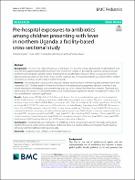| dc.contributor.author | Nyeko, Richard | |
| dc.contributor.author | Otim, Felix | |
| dc.contributor.author | Obiya, Evelyn Miriam | |
| dc.contributor.author | Abala, Catherine | |
| dc.date.accessioned | 2022-06-02T10:43:12Z | |
| dc.date.available | 2022-06-02T10:43:12Z | |
| dc.date.issued | 2022 | |
| dc.identifier.citation | Nyeko, R., Otim, F., Obiya, E. M., & Abala, C. (2022). Pre-hospital exposures to antibiotics among children presenting with fever in northern Uganda: A facility-based cross-sectional study. BMC Pediatrics, 22(1), 322. https://doi.org/10.1186/s12887-022-03375-2 | en_US |
| dc.identifier.uri | https://hdl.handle.net/123456789/412 | |
| dc.description.abstract | Abstract
Background: The rise in the indiscriminate use of antibiotics has become a major global public health problem and
presents the biggest global health challenge in the twenty-first century. In developing countries, caregivers initiate
treatment with antibiotics at home before presentation to a health facility. However, there is a paucity of evolving
data towards surveillance of this trend in low-income countries. We investigated antibiotic use among febrile children
presenting to a tertiary health facility in northern Uganda.
Methods: We conducted a cross-sectional study in a tertiary health facility in northern Uganda between March and
September 2021. Children aged 6–59 months with fever were selected using systematic random sampling. A pretested
interviewer-administered questionnaire was used the collect clinical data from the caregivers. Data were analyzed
using SPSS version 23. Descriptive statistics and multiple logistic regression models were applied. P-value < 0.05
was considered for statistical significance.
Results: Eighty-three (39.5%) of the 210 children with fever in this study used antibiotics prior to the hospital visit,
55.4% of which were on a self-medication basis, while 44.6% were empiric prescriptions. The most commonly used
antibiotics were amoxicillin 33/83 (39.8%), erythromycin 18 (21.7%), metronidazole 14 (16.9%), ciprofloxacin 13 (15.7%)
and ampicillin 6 (7.2%). The main sources of the antibiotics included buying from drug shops 30/83 (36.1%), issuance
from clinics (33.7%), remnants at home (12.0%), picking from a neighbour (7.2%) and others (10.8%). The factors associated
with antibiotic use among the febrile children were residence (p < 0.001); distance from the nearest health facility
(p = 0.005); caregivers’ gender (p = 0.043); cough (p = 0.012); diarrhoea (p = 0.007); duration of fever (p = 0.002); perceived
convulsion complicating fever (p = 0.026), and caregivers’ perception that fever (p = 0.001), cough (p = 0.003),
diarrhoea (p < 0.001) and any infection (p < 0.001) are indications for antibiotics.
Conclusions: Inappropriate use of antibiotics for childhood febrile illnesses is prevalent in the study setting, facilitated
by the ease of access and use of leftover antibiotics. There is a need to address communities’ health-seeking
behaviour and the health providers’ practice alike. | en_US |
| dc.language.iso | en | en_US |
| dc.publisher | BMC Pediatrics | en_US |
| dc.subject | Antibiotic | en_US |
| dc.subject | Fever | en_US |
| dc.subject | Children | en_US |
| dc.subject | Antimicrobial resistance | en_US |
| dc.title | Pre‑hospital exposures to antibiotics among children presenting with fever in northern Uganda: a facility‑based cross‑sectional study | en_US |
| dc.type | Article | en_US |

